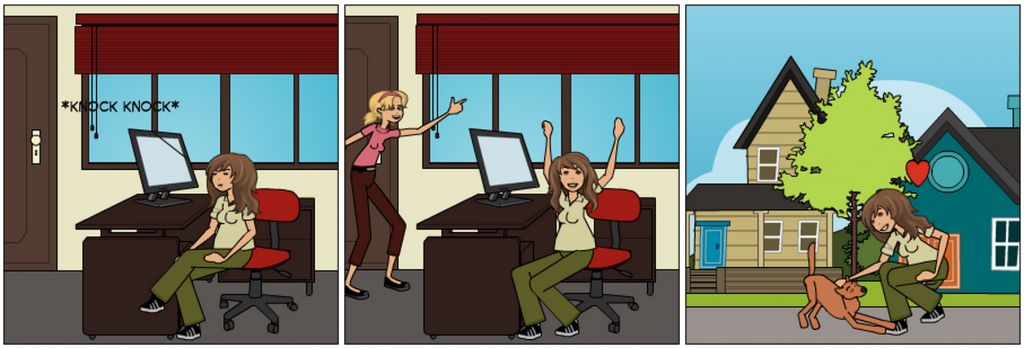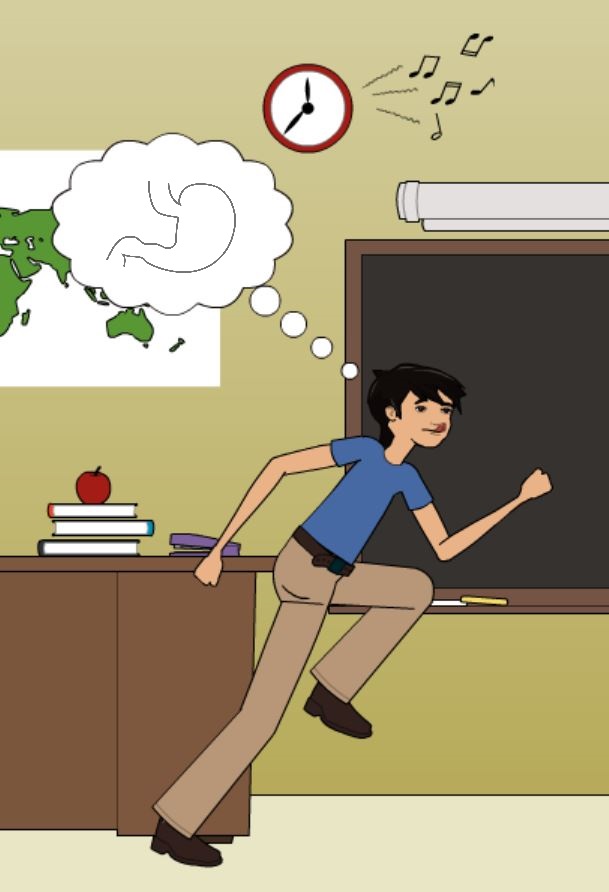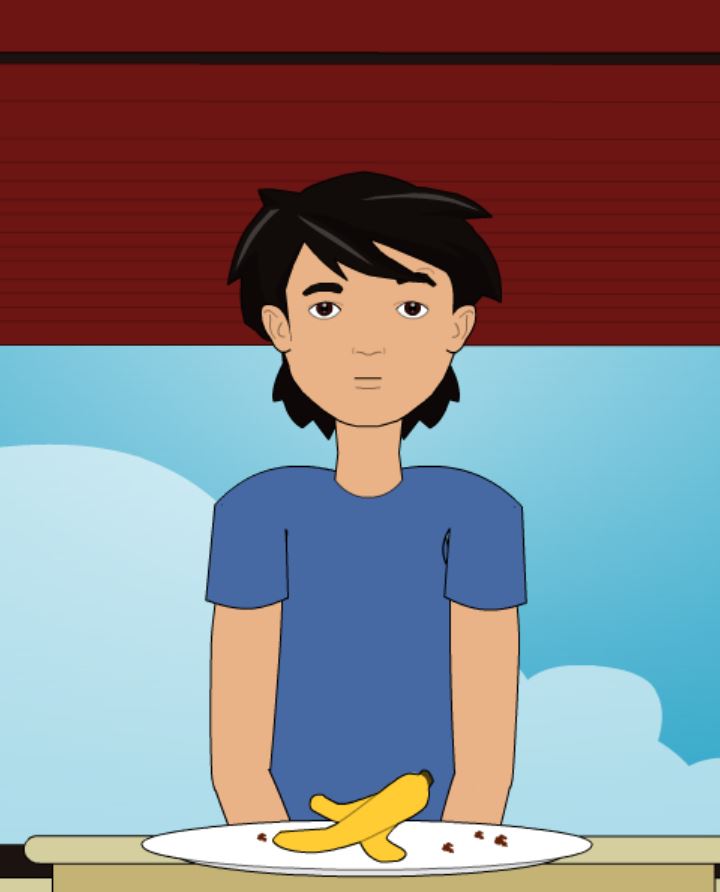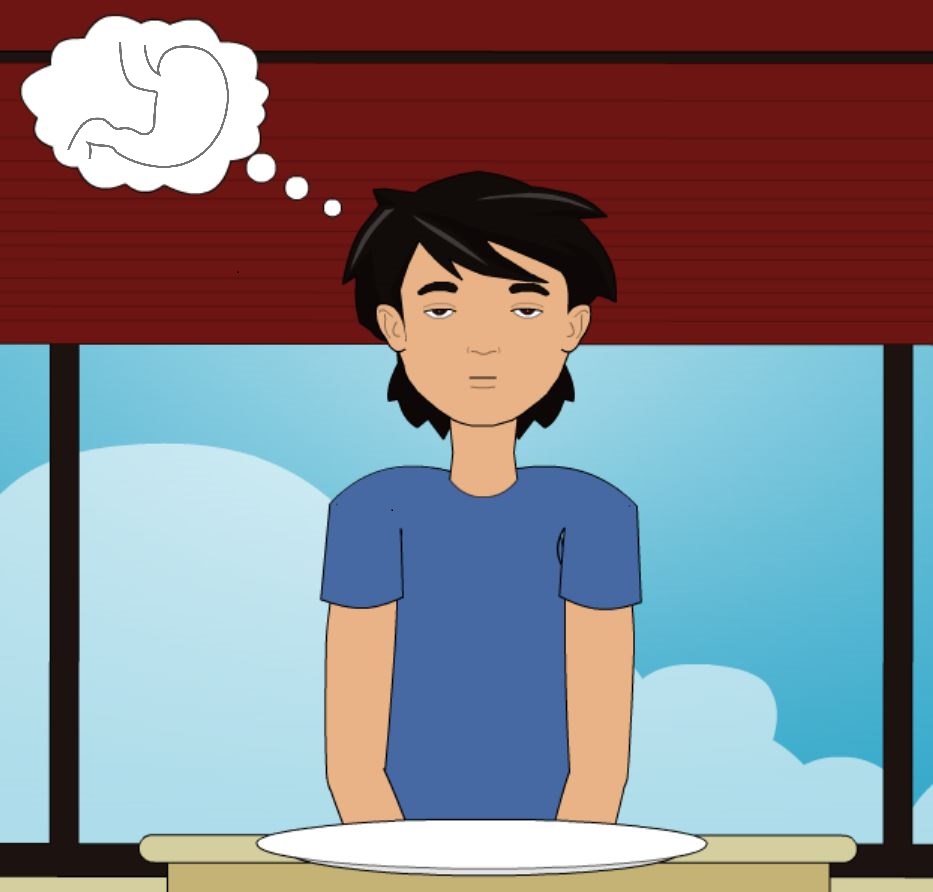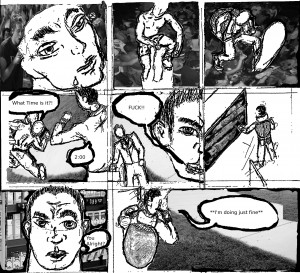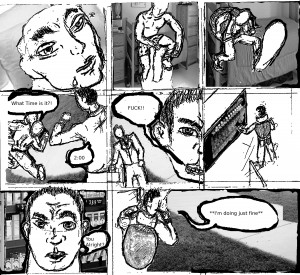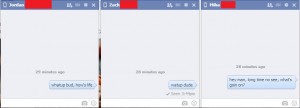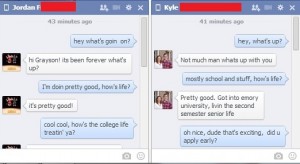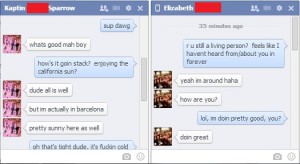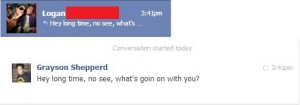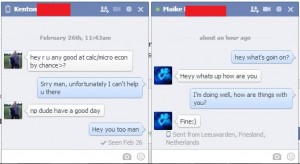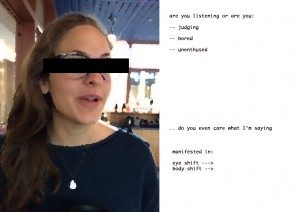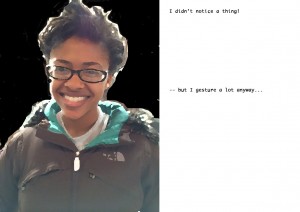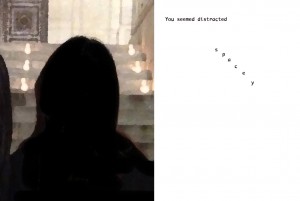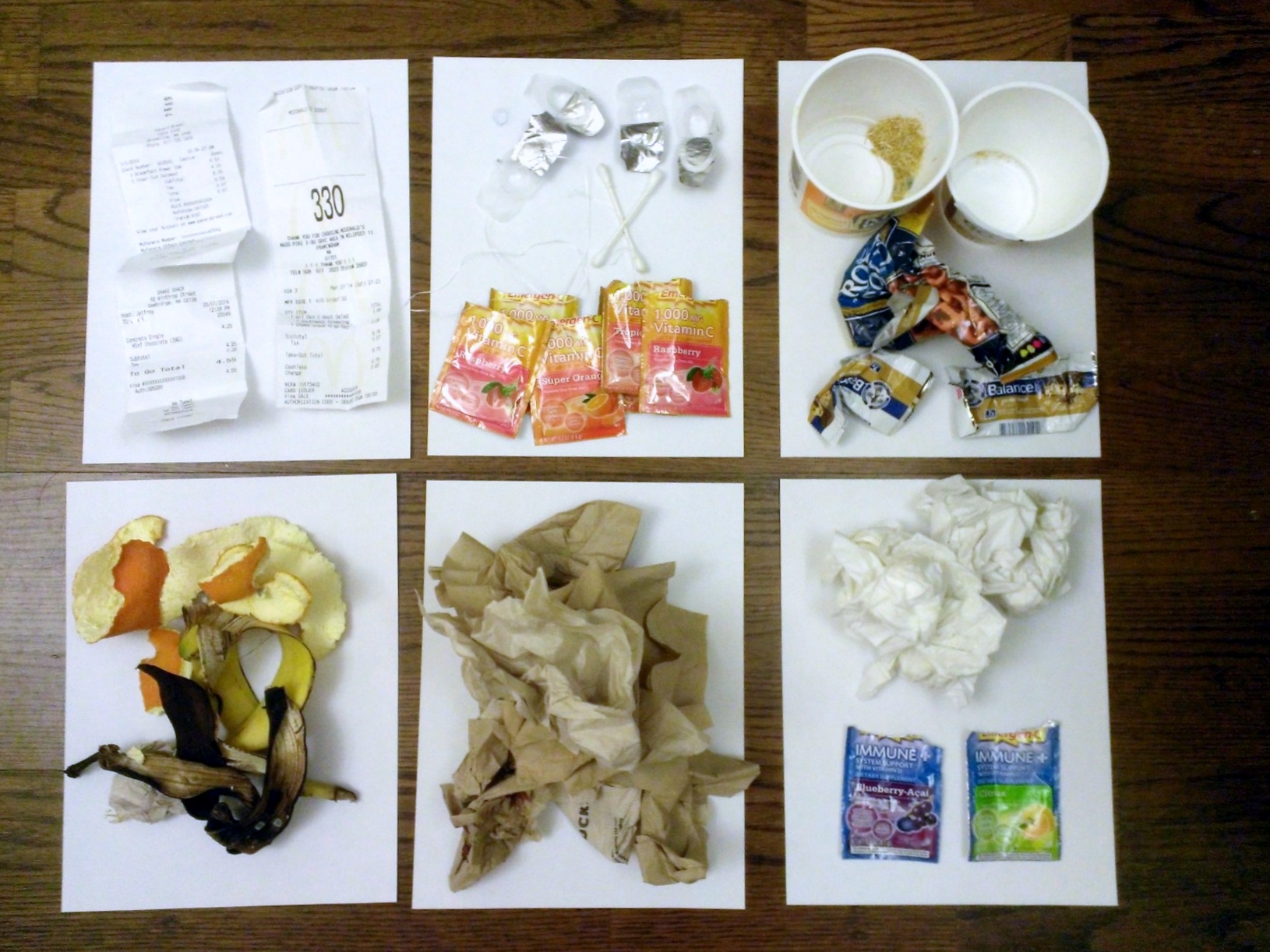For context, I tell a variation of this story once every few days. The last panel is always the same.
Experiment 4: Self-Representation
Late experiment 2
Experiment 3 AKW
Anonymous texts
For this experiment, I wanted to disrupt the social expectations of Princeton where everyone has their own social bubble where they exist and are comfortable. I wanted to create “event” where people are confronted with a situation that forces them to go outside of this comfortable social bubble and see what happens. To do this, I chose to send anonymous texts to Princeton students to see how they might react.
You can find the link here: http://www.scrollkit.com/s/r1Z93zo
Catching Up
I went to a small high school. Less than 500 students in the entire school. For my experiment I sent facebook messages to old classmates. But only, to classmates I didn’t know particularly well. This meant that while all of them would know who I am, none of them would expect to receive a facebook message from me. For the most part I tried to choose classmates who I had never spoken to on facebook at all, even while we were in school together.
So in this case it was hard to get the sample that I wanted since I was restrained by whether or not my old classmates were online or not, but the basic idea was that I would select a few classmates and divide them based on gender and on whether they were older younger or the same age as me.
At first I had trouble getting responses.
However, after a while I got my first few bites. And I noticed a few things. In general, students who were younger than me responded, and did so quickly.
Youngins:
and pretty much anyone who was in my class responded as well (admittedly tho I knew these two pretty well),
and I didn’t get a single response from anyone older than me.
and just for fun here are some extra examples. The one on the left was a guy I met at wrestling camp around 4 years ago. I’ve had no contact with him other than this message I received the other. This gave me a good chance to be on the other side of the experiment which I thought was interesting. The girl on the left was an Au Pair from Germany who I met at the beginning of freshman year. I hadn’t spoken to her since then
Experiment 3: Firestone and Fitz
As an English major, I spend a lot of time on the C Floor of Firestone. Although already not one of the brightest or most welcoming floors of the library, the recent construction which drywalled off a large part of it has made it particularly depressing for me. I miss strolling the dank, poorly lit aisles of the South West wing, seemingly traveling back in time to the 1970s while browsing literary criticism. Yet, despite the circuitous detour one must now take to reach the study spaces and most of the books, I still love the C Floor. So, for this experiment I thought I might make it more inviting with the addition of a friendly face.
My roommate and I (also an English major) acquired some time ago a cardboard cut-out of F. Scott Fitzgerald, whom we affectionately call Fitz.

I decided to make him the first thing people would see as they got off the elevators to the C floor.
The C floor is the kind of place people familiar with it tend to walk through without seeing. I hoped, with such a deviation from the prosaic, that I might encourage a few to see the C floor more actively.

He’s not easily recognizable, as this is a middle-aged Fitz, not the young fresh-out-of-Princeton burgeoning author some might know, but I appreciated the added confusion this created. I placed him right next to the “information center” and moved the “Atrium” arrow sign from its original place so that it was right next to him, as if to suggest he were a helpful librarian offering maps and guidance.
After a while I added his name tag:

 *
*
*his real signature (class year added)
Part of my tactic was complete detachment and indifference. I wanted Fitz to seem as if he had as much right to be there as anyone, as if he were at home (and should he not be? Firestone was not built in his day but the C-floor is where most of his works (at least the publicly accessible ones) are kept [PS3511.I9]). My stance was to situate myself at a desk somewhat at a distance from Fitz and appear to be working, such that when people exited the elevator they would not immediately associate me with the figure. I also would very purposely not make eye contact with any individuals I noticed noticing Fitz, so that it would not appear as if I were expecting a reaction from them. The idea was to allow the reactions to be in their purest form. If asked, I planned to not give direct answers (unless asked by a librarian or security guard who looked displeased with Fitz’s presence).
Additionally, before setting up Fitz, I sat in my chosen spot for an hour – establishing my presence in the space and thus my innocence to those who passed through multiple times. The best was a group of several construction workers who exited an elevator, in what one of them termed “a parade,” before the installation of Fitz. Half an hour later they paraded back, now past Fitz’s smiling face, while I still sat nonchalantly working on my laptop as they had seen me earlier. Two of them laughed and they did ask each other about it – which proved a theory I had in mind: that people would only remark about Fitz if with a companion who could confirm it as an anomaly (since I refused to be a source of empathy). Most people were alone.
Finally, I added a sign that said “Welcome to the C floor!”

This would be Fitz in his final state, and I think he adds very much to the C floor as such.
Alas, this experiment would have been better with a hidden camera! I would’ve liked to have captured the many confused, contemplative looks I saw, since few people said anything. I wanted to see how long it would take for someone to address me or to ask the library staff about it. My goal was to pretend that his presence was normal though it obviously was not, and it appeared that, ultimately, people bought it. Even library staff did not question it or me (which is how I anticipated the experiment might abruptly end).
Rough statistics:
4 people charged out of the elevator past him with little a second glance
5 people gave prolonged double takes but not much else
5 people looked at him intensely
4 people looked at him intensely, left, then came back and looked at him intensely again
7 people (after the addition of the name tag) squinted at his name tag
3 people (after the addition of the name tag) said “F. Scott Fitzgerald” audibly
3 people chuckled
0 people addressed me or, within my hearing distance, inquired of anyone else about him
Limitations:
- Time. Specifically, fitting my schedule to when Firestone is open. This was in fact my second attempt. I at first tried late one night but it became clear that no one enters the C floor that late, they only leave it. I then tried the next morning and though there was a lot of foot traffic it was mainly of library staff and construction workers, not my target audience—students. So, given more time and planning I would choose a peak period, I imagine around early evening. In the end, he was only up for about an hour.
- Lack of technology. Specifically, a hidden camera.
- Fitz is precious. Specifically, I would have loved to leave him somewhere an extended period of time to see what would have happened (would a student have taken a picture of him and posted it to Facebook? Would librarians have moved him?), but I could not risk something happening to him.
A Lack of Affirmation – Experiment 3
Hypothesis: This is a culture of affirmation.
Self-esteem and individualism rules; at any given point we are told it’s paramount to believe in ourselves, to know that what we are doing is ‘ok’. This affirmation works both ways. In any conversation, I would nearly guarantee that your fellow converser is nodding along to what you say, murmuring “mmmhmmm”s or “yeah, yeah”s; pick at random from a list of affirming gestures or statements — you probably have faced one from the person you are speaking with.
So what happens when we take it away? Just a steady, focused stare — no statements until the person opposite you stops speaking. This isn’t to say you lack animation, but rather you hold off on any type of affirmation or negation or feedback until the person has stopped speaking. I had hoped that such focused attention would make people feel as if they were being attended to with great focus. Unfortunately, the opposite follows.
Three friends became my guinea pigs. I sat them down for lunch or dinner one-on-one:
Person A:
Person B:
Person C:
Blacked-out : the change. Person A it was her eyes — constantly moving, unable to keep eye-contact. Person B stated post-experiment that she noticed nothing. She is fine. Person C it was rather not her at all, but me that she found to be at fault.
I have the pleasure of being friends with each of these persons, so it was clear to me deviations in our normal patterns of conversation. Across all three, regardless of their feedback, I could watch as statements that would come across strong, firm, assertive, trailed slowly of into questions given the absence of a nod of my head or a sprinkling of affirmation of their words. The intonation of a statement became a question.
More surprisingly (though ad-hoc I suppose I am not surprised) it seems that the persons A and C noted that my intention — to appear more focused on them than usual — fell far short of the mark. Rather, they both noted that I seemed to not be paying attention at all. Person A specifically thought I was deriding her statements, judging her, implicitly telling her to stop.
Most startling: in the end I was the most uncomfortable — to not affirm someone else’s words caused me great strain and tension.
It seems that just listening isn’t quite good enough. For you or me.
Results unsurprising.
http://www.princeton.edu/~eportnoy/experiment3.html
Humans are gullible. Boring results ensue.
Inventory: trash is the window into another man’s life
All items found in a student’s trash can at 11:38pm on March 3, 2014 in a Princeton dorm hallway.
Thankfully no one saw me pull up the trash bag from the can as it sat in front of the student’s door. A few hallmates did look, however, at me strangely as I walked towards and into my room with an irregular-shaped, non-empty bag of trash. It was not a rainy day so it was clear that I wasn’t using the trash bag as a cover for whatever I was carrying inside the lumpy bag.
In my room, I used a new trash bag as a glove as I pulled out each item from the trash and placed it on a white sheet of paper. I placed the items in groups to create some sort of order in the trash (below), but can there be order in trash? I unfortunately did not think about recording the order of the items in the trash (from top to bottom) to determine some sort of chronology for the trash.
From the trash, I could gather much information about what the individual had eaten (from the wrappers, peels, and receipts), worn (contacts), and used (napkins, Q-tips, floss) recently. I could also gather a few places where the individual had gone in the past week (from the receipts). But really trying to determine more information about the individual and his/her habits was pure speculation. Was this even all his/her trash? Maybe a friend had visited the individual’s room and this friend left some trash in the individual’s room. This event would be recorded by the trash contents. The trash does provide a record but unless the individual can shed light on the contents, my knowledge of the individual is relatively limited. I gathered so much information but also so little at the same time. Who can know? Who wants to know? Why am I even looking through someone’s trash? But, to be honest, it was interesting…at least the trash was relatively simple without any scandalous or creepy contents that I did not want to touch or have knowledge of.
- 3 receipts: Panera Bread (1 Breakfast Power Sandwich + 1 Steel Cut Oatmeal; total $8.97), Shake Shack (Concrete Single MInT Chocolate; total $4.55), McDonald’s (1 Grilled Chicken Southwest Salad + 1 ChpBQ Snack Wrap; total $8.75)
- 4 empty contact lens cases: 2 cases of -8.0 prescription. 2 cases of -8.5 prescription.
- 1 dried up contact lens
- 2 used Q-tips
- 1 string of floss
- 6 empty packs of Emergen-C: 3 Orange flavor, 2 Raspberry flavor, 1 Tropical flavor
- 2 empty cereal bowls: 1 Frosted Mini Wheats (with some leftovers inside), 1 Kashi GOLEAN Crunch!
- 1 empty Rold Gold Pretzel bag
- 2 empty Balance Cookie Dough bar wrappers
- 2 banana peels: 1 dried and hard (with brown napkin stuck to it), 1 soft
- Approximately 1 orange peel (dried, hard)
- 10 brown napkins: 1 had a dark red stain on it
- 6 white napkins
- 2 empty packs of Emergen-C Immune+: 1 Blueberry Acai flavor, 1 Citrus flavor
Experiment 2: Expectation vs. Reality
Image
Sorry it’s a word document! I am not the best with computer programs 🙂

